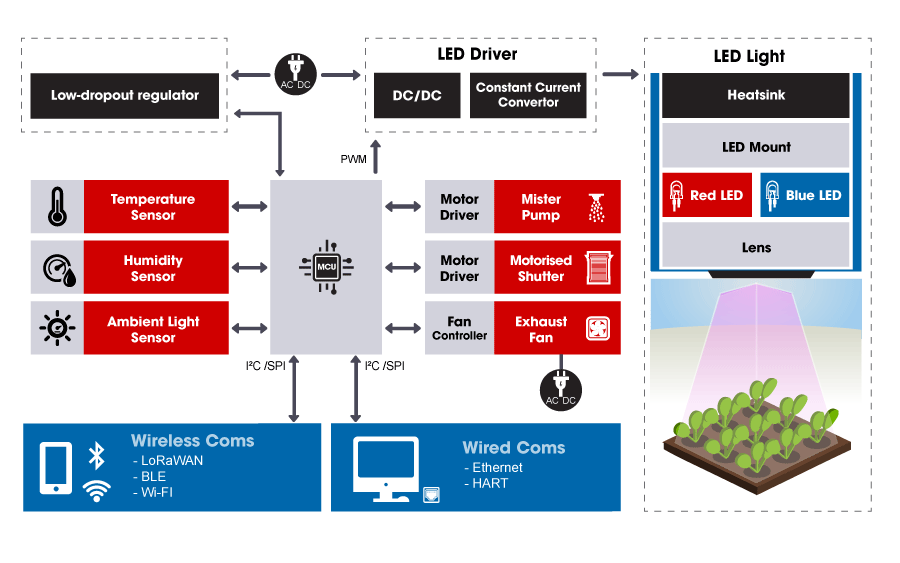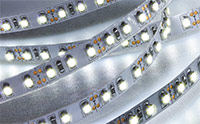
|
LED Adoption
In 50 years LEDs have developed from a tiny red glow to a more efficient, reliable and controllable replacement in almost every conceivable application. From floodlighting to medical uses, domestic and workplace environments, in all the major wattages and fittings, LEDs are everywhere.
LEDs are commonly used in a whole host of applications such as monitors and flat screen televisions, smart phones and tablets, car headlights and indicator lamps, traffic lights and Christmas tree lights, signage and entertainment applications. As energy-efficient LED technology develops, so do our uses for LEDs.
Interesting LED Facts
- Heat is what causes traditional light bulbs to shine (incandescence), whereas electrical voltage itself makes LEDs shine (electroluminescence).
- LEDs low UV content makes them far less attractive to insects than traditional lights.
- Good quality LEDs can easily exceed 50,000 hours lifetime – that’s over 5 ½ years of continuous use!
Blue LEDs can help keep food fresher. They have a strong antibacterial effect on foodborne pathogens leading to their increased usage in fridges. - Times Square’s 12ft New Year’s Eve ball is illuminated with 32,256 LEDs! Overall the ball can display 16 million colours enabling its mesmerising kaleidoscope pattern effects.
Led grow lights for horticulture
LEDs can significantly stimulate plant growth while drastically reducing energy consumption using more targeted lighting. An emerging trend, set to become a mega-trend in the not too distant future, is the concept of urban farming or gardening. With the earth’s population continually increasing it will become ever more challenging to meet consumer demands for fresh produce.
Urban farming concepts include skyscraper farms, underground farms and rooftop farms producing fresh fruits, vegetables and grains within urban areas. This reduces transportation costs and carbon footprint in addition to minimising land usage, and makes it possible to produce crops all year round in any part of the world. In fact, astronauts recently ate the first food grown off the planet Earth using LED lights to simulate the natural growing cycle.

LEDs for smart streetlights
Around the world authorities are switching to LED streetlights for increased visibility and reduced energy consumption.
In the UK for example, West Berkshire Council is finishing a £7M upgrade scheme to replace 10,000 non-LED streetlights. All new lights are fitted with a remote monitoring system to ensure maximum energy savings.
With so many great reasons to use LEDs what are you waiting for?
Types of LED
 Coloured LEDs
Coloured LEDsWavelength is used to differentiate coloured, infrared and ultra-violet LEDs, but not white LEDs.
LED wavelength is determined by the semiconductor material used within it. The wavelength value will give you an idea of the colour the LED will emit, however, always test how it looks in a real-life scenario before buying in bulk.
See all visible LEDS
 White LEDs
White LEDsYou might think white is white but actually there is a vast range of white hues and tones to choose from since white LEDs are not actually white. In fact the white effect we see is created by mixing red, green and blue LEDs. White LEDs can also be created by coating a blue LED with yellow phosphor to emit a light which appears white to the human eye.
You can select the right kind of white for purpose by using colour temperature. Warm whites have a yellow-red tone and are cosy and calming. These are often used in homes, hotels and restaurants and imitate a candlelight tone. Cool whites have an icy blue tone. These are harsher and tend to be used in industrial environments and street lighting. Neutral whites sit between the two and are the preferred choice for classrooms, retail and office environments.
The appearance of white light (colour temperature) is measured in Kelvin (K). Basically, the lower the value the warmer the white. The best way to tell is to check the colour temperature value of the LED you plan to use against a colour temperature chart.
See all White LEDs
 IR and UV LEDs
IR and UV LEDsWhen we think of LEDs in the typical sense, it’s those we can see in the visible light spectrum, but there are also infrared (IR) LEDs which are commonly found in remote controls and ANPR (automatic number plate recognition) as well as touchscreens, motion sensors and smart watches.
Because all objects on Earth emit infrared radiation (IR) or heat which can be detected by electronic sensors, one of the most useful applications of the IR spectrum is detection and sensing, as used in security cameras and night vision googles. Infrared LEDs are positioned around the outside of the camera or goggle lens and can see/capture IR images in zero-light conditions and even through smoke or fog.
See all IR LEDs
Another common LED is ultra-violet (UV), commonplace in tanning salons, aquarium lights and medical treatments. The large UV curing (instant curing of adhesives, inks and coatings) market is adopting UV LEDs now that they have reached power densities that make them competitive with other UV lamps and light sources. UV LEDs are also safer, with lower levels of UV radiation emitted.
The UV LED market is set to grow significantly as applications expand from UV curing to water purification and disinfection applications.
See all UV LEDs
New for you in LED Lighting
LED drivers and power supplies
One of the first factors to consider (having chosen your desired LED) is what type of driver you need. Whether you need a constant current (CC) or constant voltage (CV) depends on the module or LED you need to power and this information will be supplied with the product.
Some LED drivers are dual-purpose and have options for both CC and CV. These tend to run as CV as standard, switching over to CC mode when output power passes the rated current limit.
Our Favourite DesignSpark LED Posts
LED connectors and heatsinks
Of course to ensure your LEDs work with maximum effectiveness and efficiency, you’ll need the right infrastructure to go around them. In addition to the actual LED(s), you need to consider what other components you will require. These may include power supply, connectors, cables, mounts or holders.
It is a common misconception that LEDs do not produce heat. In fact, the majority of the electricity used in an LED (around 70%) is transformed into heat rather than light. The heat needs to be removed at source because if your LED runs too hot it will fail, using correct heatsinks will ensure maximum operating life and efficiency.
This is what makes the heatsink so important. In general, heatsinks can remove heat in three ways:
- Conduction: transfer of heat from one solid to another
- Convection: transfer of heat from a solid to a moving ‘fluid’ (in LED terms the fluid is most likely to be air)
- Radiation: transfer of heat through thermal radiation


































